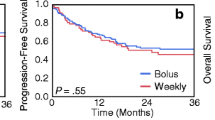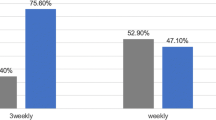Abstract
Purpose
The optimal dosage and frequency of platinum-based chemoradiotherapy (CRT) regimen for treating advanced head and neck squamous cell carcinoma remains unresolved. This study aims to compare the toxicity and efficacy of weekly versus more dose-intensive cisplatin-based CRTs.
Methods
We reviewed 155 stage III/IV head and neck squamous cell carcinoma patients with no evidence of distant metastasis treated with one of two CRT regimens from 2000 to 2010 at Greater Baltimore Medical Center. Twice-daily radiation was provided as a split course over a 45-day period. Regimen A consisted of concomitant cisplatin (30 mg/m2/1 h) weekly for 6 cycles; regimen B consisted of concomitant cisplatin (12 mg/m2/1 h) and 5-fluorouracil (600 mg/m2/20 h) on days 1 through 5 and days 29 through 33. Main outcome measures included acute toxicities (myelosuppression, neurotoxicity, nephrotoxicity, gastrointestinal dysfunction), unplanned hospitalizations, and disease control at 12 months.
Results
Patients on regimen A were much less likely to experience ototoxicity due to their treatment (0% vs. 9.8%, P = 0.04). They were more likely to experience thrombocytopenia acutely (46% vs. 26%, P = 0.02), but the toxicity was not limiting (grade 1–2). No significant differences exist in the incidence of other toxicities or unplanned hospitalizations. At 1 year, 97% of patients on A vs. 86% of patients on regimen B were free of disease (P = 0.11).
Conclusions
With concurrent radiotherapy, low-dose, single-agent, weekly cisplatin is less likely than higher-dose daily cisplatin plus 5-fluorouracil provided at the beginning and end of treatment to be associated with ototoxicity. The preliminary data suggest at least equivalent efficacy, but longer follow-up is required.
Similar content being viewed by others
References
Adelstein DJ, Li Y, Adams GL, et al. An intergroup phase III comparison of standard radiation therapy and two schedules of concurrent chemoradiotherapy in patients with unresectable squamous cell head and neck cancer. J Clin Oncol. 2003;21:92–8.
Forastiere AA, Goepfert H, Maor M, et al. Concurrent chemotherapy and radiotherapy for organ preservation in advanced laryngeal cancer. N Engl J Med. 2003;349:2091–8.
Forastiere AA, Maor M, Weber RS, et al. Long-term results of Intergroup RTOG 91-11: a phase III trial to preserve the larynx—induction cisplatin/5-FU and radiation therapy versus concurrent cisplatin and radiation therapy versus radiation therapy. J Clin Oncol. 2006;24(18 Suppl):5517.
Al-Sarraf M, LeBlanc M, Giri PG, et al. Chemoradiotherapy versus radiotherapy in patients with advanced nasopharyngeal cancer: phase III randomized Intergroup study 0099. J Clin Oncol. 1998;16:1310–7.
Fowler JF, Lindstrom MJ. Loss of local control with prolongation in radiotherapy. Int J Radiat Oncol Biol Phys. 1992;23:457–67.
Robertson C, Robertson AG, Hendry JH, et al. Similar decreases in local tumor control are calculated for treatment protraction and for interruptions in the radiotherapy of carcinoma of the larynx in four centers. Int J Radiat Oncol Biol Phys. 1998;40:319–29.
Rademaker-Lakhai JM, Crul M, Zuur L, et al. Relationship between cisplatin administration and the development of ototoxicity. J Clin Oncol. 2006;24:918–24.
Macdonald JS. Toxicity of 5-fluorouracil. Oncology (Williston Park, NY). 1999;13(7 Suppl 3):33–4.
Low WK, Toh ST, Wee J, Fook-Chong SMC, Wang DY. Sensorineural hearing loss after radiotherapy and chemoradiotherapy: a single, blinded, randomized study. J Clin Oncol. 2006;24:1904–9.
Seikaly H, Jha N, Harris JR, et al. Long-term outcomes of submandibular gland transfer for prevention of postradiation xerostomia. Arch Otolaryngol Head Neck Surg. 2004;130:956–61.
Rieger J, Seikaly H, Jha N, et al. Submandibular gland transfer for prevention of xerostomia after radiation therapy: swallowing outcomes. Arch Otolaryngol Head Neck Surg. 2005;131:140–5.
Eisbruch A, Ship JA, Martel MK, et al. Parotid gland sparing in patients undergoing bilateral head and neck irradiation: techniques and early results. Int J Radiat Oncol Biol Phys. 1996;36:469–80.
Wasserman TH, Brizel DM, Henke M, et al. Influence of intravenous amifostine on xerostomia, tumor control, and survival after radiotherapy for head-and- neck cancer: 2-year follow-up of a prospective, randomized, phase III trial. Int J Radiat Oncol Biol Phys. 2005;63:985–90.
Eisbruch A, Kim HM, Terrell JE, et al. Xerostomia and its predictors following parotid-sparing irradiation of head-and-neck cancer. Int J Radiat Oncol Biol Phys. 2001;50:695–704.
Cox DR. Regression models and life-tables. J R Stat Soc B. 1972;34:187–220.
Browman GP, Hodson DI, Mackenzie RJ, Bestic N, Zuraw L. Choosing a concomitant chemotherapy and radiotherapy regimen for squamous cell head and neck cancer: A systematic review of the published literature with subgroup analysis. Head Neck. 2001;23:579–89.
Garden AS, Harris J, Vokes EE, et al. Preliminary results of Radiation Therapy Oncology Group 97-03: a randomized phase ii trial of concurrent radiation and chemotherapy for advanced squamous cell carcinomas of the head and neck. J Clin Oncol. 2004;22:2856–64.
Adelstein DJ, Saxton JP, Lavertu P, et al. A phase III randomized trial comparing concurrent chemotherapy and radiotherapy with radiotherapy alone in resectable stage III and IV squamous cell head and neck cancer: preliminary results. Head Neck. 1997;19:567–75.
Jeremic B, Milicic B, Dagovic A, Vaskovic Z, Tadic L. Radiation therapy with or without concurrent low-dose daily chemotherapy in locally advanced, nonmetastatic squamous cell carcinoma of the head and neck. J Clin Oncol. 2004;22:3540–8.
Flood W, Lee DJ, Trotti A, et al. Multimodality therapy of patients with locally advanced squamous cell cancer of the head and neck: preliminary results of two pilot trials using paclitaxel and cisplatin. Semin Radiat Oncol. 1999;9(2 Suppl 1):64–9.
Brizel DM, Albers ME, Fisher SR, et al. Hyperfractionated irradiation with or without concurrent chemotherapy for locally advanced head and neck cancer. N Engl J Med. 1998;338:1798–804.
Huguenin P, Glanzmann C, Taussky D, et al. Hyperfractionated radiotherapy and simultaneous cisplatin for stage-III and -IV carcinomas of the head and neck. Long-term results including functional outcome. Strahlenther Onkol. 1998;174:397–402.
Taylor SG, Murthy AK, Vannetzel JM, et al. Randomized comparison of neoadjuvant cisplatin and fluorouracil infusion followed by radiation versus concomitant treatment in advanced head and neck cancer. J Clin Oncol. 1994;12:385–95.
Polkinghorn WR, Dunkel IJ, Souweidane MM, et al. Disease control and ototoxicity using intensity-modulated radiation therapy tumor-bed boost for medulloblastoma. Int J Radiat Oncol Biol Phys. 2011;81:e15–20.
Wakisaka H, Yamada H, Motoyoshi K, et al. Incidence of long-term ipsilateral and contralateral ototoxicity following radiotherapy for nasopharyngeal carcinoma. Auris Nasus Larynx. 2011;38:95–100.
Bhandare N, Jackson A, Eisbruch A, et al. Radiation therapy and hearing loss. Int J Radiat Oncol Biol Phys. 2010;76(3 Suppl):S50–7.
Franzén L, Funegård U, Ericson T, Henriksson R. Parotid gland function during and following radiotherapy of malignancies in the head and neck. A consecutive study of salivary flow and patient discomfort. Eur J Cancer. 1992;28:457–62.
Lin A. Quality of life after parotid-sparing IMRT for head-and-neck cancer: a prospective longitudinal study. Int J Radiat Oncol. 2003;57:61–70.
Yao M. Health-related quality-of-life outcomes following IMRT versus conventional radiotherapy for oropharyngeal squamous cell carcinoma. Int J Radiat Oncol. 2007;69:1354–60.
Kam MKM. Prospective randomized study of intensity-modulated radiotherapy on salivary gland function in early-stage nasopharyngeal carcinoma patients. J Clin Oncol. 2007;25:4873–9.
Lee NY. Concurrent chemotherapy and intensity-modulated radiotherapy for locoregionally advanced laryngeal and hypopharyngeal cancers. Int J Radiat Oncol. 2007;69:459–68.
Graff P. Impact of intensity-modulated radiotherapy on health-related quality of life for head and neck cancer patients: matched-pair comparison with conventional radiotherapy. Int J Radiat Oncol. 2007;67:1309–17.
Parliament MB. Preservation of oral health-related quality of life and salivary flow rates after inverse-planned intensity- modulated radiotherapy (IMRT) for head-and-neck cancer. Int J Radiat Oncol. 2004;58:663–73.
Daly ME. Evaluation of patterns of failure and subjective salivary function in patients treated with intensity modulated radiotherapy for head and neck squamous cell carcinoma. Head Neck. 2007;29:211–20.
Lee NY. A comparison of intensity-modulated radiation therapy and concomitant boost radiotherapy in the setting of concurrent chemotherapy for locally advanced oropharyngeal carcinoma. Int J Radiat Oncol. 2006;66:966–74.
Brizel DM, Wasserman TH, Henke M, et al. Phase III randomized trial of amifostine as a radioprotector in head and neck cancer. J Clin Oncol. 2000;18:3339–45.
Büntzel J, Küttner K, Fröhlich D, Glatzel M. Selective cytoprotection with amifostine in concurrent radiochemotherapy for head and neck cancer. Ann Oncol. 1998;9:505–9.
Antonadou D, Pepelassi M, Synodinou M, Puglisi M, Throuvalas N. Prophylactic use of amifostine to prevent radiochemotherapy-induced mucositis and xerostomia in head-and-neck cancer. Int J Radiat Oncol Biol Phys. 2002;52:739–47.
Vacha P, Fehlauer F, Mahlmann B, et al. Randomized phase III trial of postoperative radiochemotherapy ± amifostine in head and neck cancer. Is there evidence for radioprotection? Strahlenther Onkol. 2003;179:385–9.
Bourhis J, Blanchard P, Maillard E, et al. Effect of amifostine on survival among patients treated with radiotherapy: a meta-analysis of individual patient data. J Clin Oncol. 2011;29:2590–7.
Hensley ML, Hagerty KL, Kewalramani T, et al. American Society of Clinical Oncology 2008 clinical practice guideline update: use of chemotherapy and radiation therapy protectants. J Clin Oncol. 2009;27:127–45.
Koukourakis MI, Kyrias G, Kakolyris S, et al. Subcutaneous administration of amifostine during fractionated radiotherapy: a randomized phase II study. J Clin Oncol. 2000;18:2226–33.
Author information
Authors and Affiliations
Corresponding author
Rights and permissions
About this article
Cite this article
Fan, K.Y., Gogineni, H., Zaboli, D. et al. Comparison of Acute Toxicities in Two Primary Chemoradiation Regimens in the Treatment of Advanced Head and Neck Squamous Cell Carcinoma. Ann Surg Oncol 19, 1980–1987 (2012). https://doi.org/10.1245/s10434-012-2219-4
Received:
Published:
Issue Date:
DOI: https://doi.org/10.1245/s10434-012-2219-4




